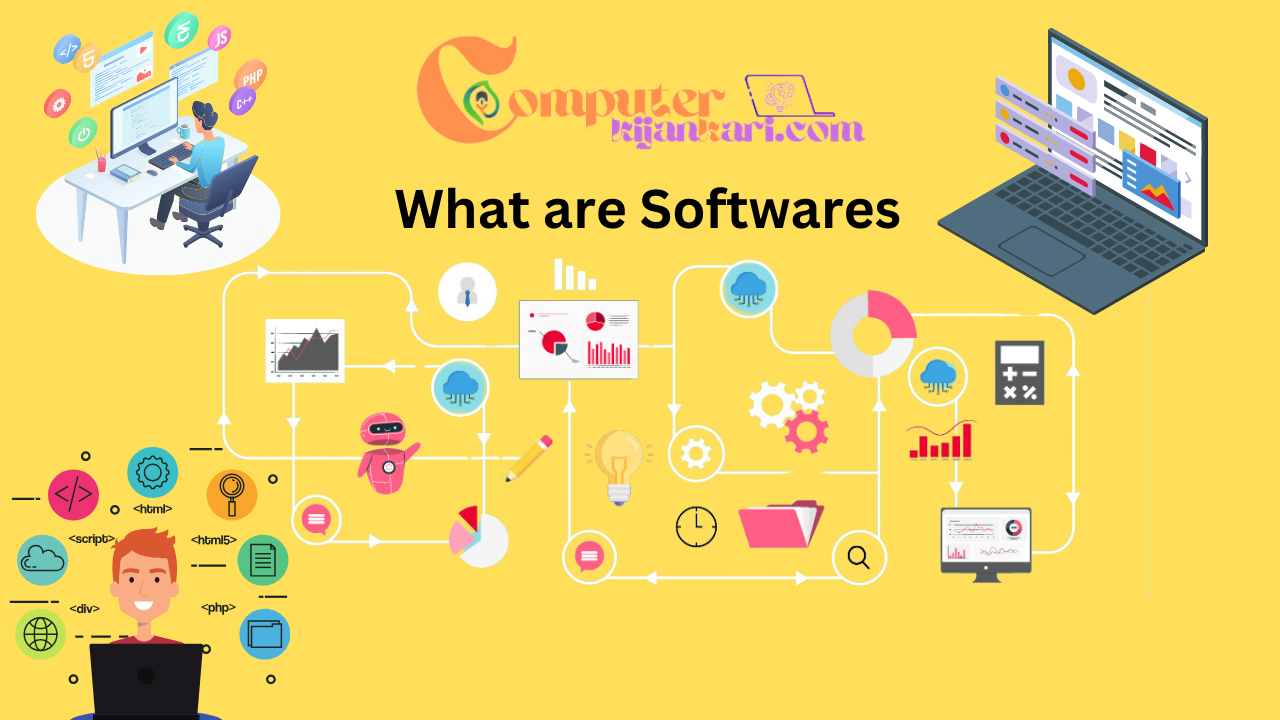Definition of Softwares.
Introduction about what are softwares
What are Softwares – In the fast-paced digital era, the term “software“ has become as ubiquitous as the devices we carry in our pockets. From smartphones to computers, we rely on software for nearly every aspect of our daily lives. But what exactly are softwares? In this blog post, we will delve into the intricate world of software, demystifying its complexities and exploring its fundamental role in shaping our digital landscape.

Understanding the Basics:
what are softwares- At its core, software refers to a set of instructions that enable a computer or other electronic device to perform specific tasks. These instructions are meticulously crafted lines of code, written by skilled developers who harness their creativity to bring functionality to our gadgets.
Types of Software:

1. System Software:
Operating Systems:
The unsung hero behind the scenes, managing hardware resources and enabling communication between the user and the computer.
Device Drivers:
Essential software that facilitates communication between the operating system and hardware components.
2. Application Software:
Productivity Software:
Tools like word processors, spreadsheets, and presentation software that enhance our work efficiency.
Entertainment Software:
From video games to media players, these applications add a touch of leisure to our digital experiences.
Utility Software:
Programs that perform specific tasks, such as antivirus software, disk cleanup tools, and file compression utilities.
3. Development Software:
Compilers: Translating human-readable code into machine language.
Integrated Development Environments (IDEs): Providing developers with a comprehensive platform to code, debug, and test their applications.
The Evolution of Software:
what are softwares -As technology advances, so does software. The evolution of software can be traced from the early days of punch cards and assembly languages to the sophisticated high-level programming languages we use today. The continuous refinement of software reflects our quest for more powerful, efficient, and user-friendly digital experiences.
Imagine a journey through time, starting from the early days of computers with punch cards and basic programming languages. The evolution of software is akin to a technological revolution, constantly refining and reinventing itself. In the beginning, software was simple and rudimentary, but over the years, it has transformed into the sophisticated, user-friendly applications we use today.
This evolution is not just about adding more features; it’s about making software more accessible, intuitive, and powerful. As technology advances, so does our ability to create software that not only meets our needs but also anticipates them. The evolution of software mirrors our own journey of discovery and progress in the digital world.
The Impact on Everyday Life:
Softwares have seamlessly woven themselves into the fabric of our daily routines. From the alarm clock app that wakes us up in the morning to the social media platforms we peruse before bedtime, our lives are intricately connected to the functionality provided by various softwares.
Challenges and Innovations:
The ubiquity of softwares brings forth challenges, including security concerns, compatibility issues, and the perpetual need for updates. However, these challenges also drive innovation. Developers are constantly striving to create more secure, user-friendly, and efficient software solutions.
In the vast landscape of software development, challenges and innovations go hand in hand, shaping the way we interact with technology. Challenges can range from ensuring the security of our digital spaces to overcoming compatibility issues between different software and hardware. Despite these hurdles, the world of software is constantly evolving through innovations.
Developers are like digital pioneers, tackling challenges head-on and finding creative solutions that push the boundaries of what’s possible. Whether it’s creating more secure software, improving user interfaces for a smoother experience, or finding ways to make applications run faster, every challenge met with innovation brings about positive changes in the digital realm.
Looking Towards the Future:
what are softwares :The future of softwares holds exciting possibilities. Artificial Intelligence (AI) and Machine Learning (ML) are poised to revolutionize the way we interact with technology. Smart homes, autonomous vehicles, and augmented reality are just glimpses of the software-driven future awaiting us.
The future of software is a thrilling prospect, filled with exciting possibilities that can change the way we live and interact with the world. Imagine a future where artificial intelligence becomes an integral part of our daily lives, predicting our needs and adapting to our preferences seamlessly. Think about smart homes that understand and respond to our habits, or augmented reality blurring the lines between the digital and physical realms.
Looking towards the future means anticipating how software will continue to transform our world. It’s about envisioning a future where technology not only serves us but enhances our lives in ways we can’t yet imagine. As we move forward, the collaboration of human creativity and technological innovation will shape the future of software, promising a world where the impossible becomes possible.
In essence, challenges and innovations, the evolution of software, and looking towards the future are interconnected chapters in the ever-evolving story of how technology impacts our lives. They represent the dynamic nature of software development, where challenges are opportunities for innovation, evolution is a constant, and the future is an open canvas waiting to be painted with the strokes of human ingenuity.
Conclusion:
In conclusion, softwares are the digital architects of our modern world. They empower our devices, streamline our tasks, and shape the way we connect with information and each other. As we navigate the ever-expanding realm of technology, understanding the essence of softwares becomes crucial. It is not just about lines of code; it is about the incredible journey of turning imagination into digital reality.

